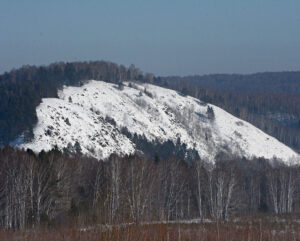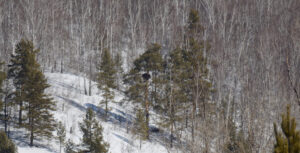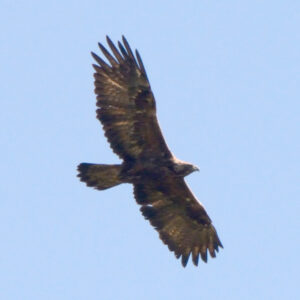Third International Scientific and Practical Conference “Eagles of the Palearctic: Study and Conservation”
Raptors Conservation. Suppl. 2. Proceedings of Conferences
NEW DATA ON GOLDEN EAGLE NESTING IN THE BERD RIVER BASIN, NOVOSIBIRS REGION, RUSSIA
Andreyenkov O.V. (Institute of Molecular and Cellular Biology SB RAS, Novosibirsk, Russia)
Contact:
Oleg Andreyenkov oleg_andreenkov@mail.ru
Recommended citation: Andreyenkov O.V. New Data on Golden Eagle Nesting in the Berd River Basin, Novosibirsk Region, Russia. – Raptors Conservation. 2023. S2: 132–137. DOI: 10.19074/1814-8654-2023-2-132-137 URL: http://rrrcn.ru/en/archives/34921
The Berd River flows along the southwestern part of the low-mountain Salair ridge and in the middle reaches has distinct mountain character. Within the Novosibirsk region, Berd and its tributaries create a unique mountain landscape area with suitable habitat for Golden Eagle (Aquila chrysaetos) nesting group with density of up to five nesting pairs per 100 km2 (Karyakin, 2005). There is only indirect evidence for Golden Eagle nesting in the Novosibirsk region outside this area. The only publication that mentions nests found in the northern areas of the region (Northern, Kyshtovsky) is Red Data Book of the Novosibirsk region (RDB NR), here data is presented as personal communications and as unpublished. The nesting density in the northern part of the Novosibirsk region is estimated to be two orders of magnitude lower than in the Berd river valley (RDB NR).
Thus, Berd river valley is the most important Golden Eagle nesting area within the region. However, all nest findings here were made more than 20 years ago: in 1995, 2002, and 2003 (Karyakin, 2005). Later, evidence of Golden Eagle presence in Berd basin was limited to single sightings of adult birds. For example, on January 14, 2018, a pair of soaring adult birds was observed near Iskitim city in bad weather (snow, blizzard) (observation in iNaturalist1 database). On August 2, 2020, an adult bird soared over a river section near one of the nests found by the expedition in 2002. However, back in 2017 we examined this breeding territory and found it devastated by fire that destroyed all large trees.
On July 17, 2021, during rafting on the route between villages Kinterep and Starososedovo, with a total route length of 40 km, three Golden Eagles were encountered during the day: fledgling with un dergrown flight and tail feathers2 soared above the river and, eight kilometers away in a straight line, a pair of adult eagles rose from a perch on the rocky cliffs of the right river bank3. Thus, two possible breeding territories’ locations were determined. It is interesting to note that according to I.V. Karyakin (2005), all eagle observations at breeding territories during expeditions in 2002–2003 were made after nests discovery. In September–October of 2021, field trips were made to summer observation points of fledgling and pair to find nests.
On September 4, 2021, a search for a nest was carried out in areas adjacent to the location of fledgling encounter. Breeding territory number one, discovered by the 2002 expedition, was examined first (see Karyakin, 2005: Fig. 1). A dead clump of old pines was found here, one of which most likely was a nesting tree back in 2002. No remains of the nest were found. At a distance of about 800 m from this breeding territory, on the rocky cliffs of the right Berd riverbank, in the immediate vicinity of the fledgling observation point, we discovered Golden Eagle perches with remains of prey (rook feathers and skeletonized remains of the harrier Circus sp.). Fresh Golden Eagle down was found on the thorny caragana bushes along the slope. An adult eagle was encountered on the territory and a nest was found. The nest was located on the left bank of the right Berd river tributary, 300 m away from its mouth in the middle of the slope overgrown with birch trees interspersed with individual old pines. The nest was located near the trunk in the lower third of the crown, on side branches facing the stream valley, and was visible from the opposite slope. During visits to the breeding territory on February 20, 2022, and March 13, 2023, individual adult eagles were encountered. On March 13, 2023, another nest was found on the territory as well. The distance between nests was 350m. The nest was located in the upper quarter of the right Berd riverbank slope in the middle of the crown and was clearly visible from the opposite bank. On June 11, 2023, a feathered nestling with patches of unshedded down on its back was found in the nest that we located on September 4.
On October 9, 2021, a search for a nest was conducted in another area near the location where Golden Eagle pair was encountered on July 17 of the same year. Similar to the previous territory, the nest was found on the left (northern) bank of the right Berd river tributary, approximately 130 m from its mouth, in the middle of a slope overgrown with birch forest interspersed with single pines and small pine clumps, in the lower third of a crown of single old pine with a nest base at a height of 13 m above ground. The height was measured during a visit to the nest on October 23, 2021, using laser rangefinder. The thickness of the nest was estimated at 2.5–3 m. Judging by the nest size and its deviation from the vertical of the upper part of the trunk, the nest age is probably at least 20 years old. This is indirectly confirmed by the fact that in 2021 eagles used the same perch as in 2003, and its position relative to the nest coincides with the positions of perches relative to the nest in the breeding territory found on September 4, 2021.

Breeding territory of the Golden Eagle (Aquila chrysaetos) in the Berd river valley. Photo by O. Andreyenkov.
Individual adult eagles were observed in the territory during visits on October 9 and 23, 2021, and during winter visits on February 8, 2022, and February 12, 2023. However, there is no evidence of eagles nesting in a discovered nest in this breeding territory in 2022 and 2023, and an attempt must be made to find other nests here.
Human economic activity is a major threat to the existence of Golden Eagle nesting groups in the Berd river basin. The constant increase in volumes of anthracite mining in the basin of the right Berd tributary, the Elbash river, have already caused Golden Eagle to stop nesting in the oldest known breeding territory on the left bank of the Elbash River. In particular, no birds were encountered, and no evidence of nesting was found when visiting the territory in 2006, 2007, 2016, and 2021. Agricultural activity has been actively developing in recent years in the Berd basin, close to Golden Eagle breeding territories. Tourism develops even more actively. The rocks of the Berd river are unique for Novosibirsk region: picturesque landscapes, the possibility of rock climbing, rafting, the use of cross-country motorcycles, ATVs, jeeps, and snowmobiles – all this attracts a large number of vacationers, increases the recreational load, and contributes to the constant disturbance of birds in breeding territories. And if such birds as, for example, Peregrine Falcons (Falco peregrinus), although suffer from disturbance, have been increasing their numbers in recent years, the situation with Golden Eagle will most likely worsen in the coming years. For example, right along the edge of the bank cliff, which was used by Golden Eagle as a hunting perch between 2003 and 2021, there is now a road used by off-road vehicles to transport vacationers to a viewing point located directly above the perch.
1 http://www.inaturalist.org/observations/70236847
2 http://www.inaturalist.org/observations/87514647
3 http://www.inaturalist.org/observations/87514974


